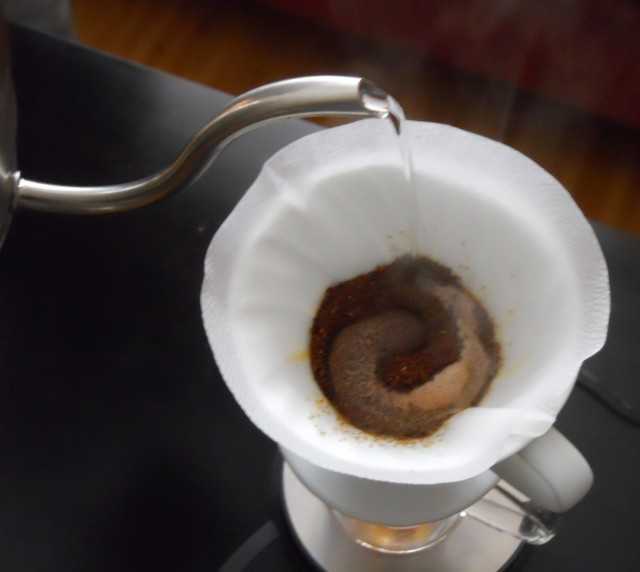One of the greatest challenges of the sleepy morning: making coffee without first having coffee to kickstart the neurons necessary to make coffee in the first place.
This desperation drives design trends toward equipment that allows easy preparation, the most typical example being the programmable auto-drip coffee maker. Add water and grounds, set a wake-up time, and come into the kitchen the next day as if elves brewed it during the night.
The problem with this, though, is that the grounds get horribly oxidized in the process. Despite its utilitarian role in the average morning routine, coffee can be a complex symphony of chemical reactions. Roasted coffee beans shed desirable flavors (and gain undesirable ones) when exposed to air. And grinding accelerates this process by increasing the surface area, so even placing ground coffee in a filter basket overnight will cause the coffee to taste stale.
The popular Keurig brewer, which makes the coffee-brewing process as simple as opening a can of beer, specifically addresses this problem. The machine makes a single cup of coffee by passing water through a vacuum-sealed plastic cup of grounds. There’s no measuring water, no scooping grounds, and no interaction with oxygen during shipping and storage. The Keurig is the ideal solution to the making-coffee-before-having-coffee problem: Push a button, wake up.
The Keurig is also the most expensive form of coffee on the planet, costing anywhere from $21.66 per pound of coffee for Folgers brand to $124.55 per pound for Arpeggio K-Cups (for comparison, $100 buys a pound of Panamanian Hacienda la Esmeralda Geisha beans, considered by some to be the finest in the world). It also produces an irresponsibly large quantity of plastic waste. But many people find this trade-off to be worth it: Everyone I know who has switched from an auto-dripper to a Keurig comments on the increased quality of the coffee and marvels at the ease. As for the waste, well, most just try not to think about it.
But another revolution is—ahem—brewing. This one values deliberation, flavor, and quality, treating coffee as something to be savored rather than pure brain fuel. It recalls the painstaking rituals of Turkish coffee (the laborious process is a means of demonstrating hospitality and devotion to one’s guests) and the precision of finicky Italian espresso machines.
This newly-prominent means of making coffee allows for an intense, individuated cup, but demands an obsessive commitment to craft and method. I am talking, as some coffee aficionados may have already guessed, about the pour-over.
Unlike espresso, which is made in a dedicated machine, or French-press coffee, which is brewed in the eponymous press pot, pour-over coffee can be produced by a variety of devices that share a few common characteristics.
From the rugged Chemex (the preferred coffeemaker of Georgia O’Keefe and James Bond) to the high-tech Aeropress, all pour-over devices work the same way: The preparer heats water and, true to the name, pours it over coffee grounds. Unlike the French press, it relies on a paper filter, which makes for a cleaner, less oily flavor.
More than any other method of making coffee, the pour-over is all about control—most die-hards insist on using a scale to measure coffee grounds and water, a measure of exactitude meant to ensure the ideal ratio and, therefore, the ideal taste.
It’s also a way to counteract the fickle nature of coffee. Auto-drippers are notorious for overheating water, which can scorch the sensitive beans and lend a foul taste to the resulting brew. Coffee made without the benefit of precise control will mask the specific chemical load of a given bean, which can vary greatly according to the region of origin, the altitude at which it was grown, and the methods used to process it.
Of course, if one is using Folger’s or the evenly burned charcoal that some shall-remain-nameless coffee franchises sell as beans, control doesn’t really matter. The rise of pour-over coffee has relied on the increased availability of direct-source, lighter-roasted specialty coffees that offer a wider range of flavor possibilities, from toasty to fruity to vegetal.
These coffees often come from not just a single region but a single farm, packaged with information about the farmer, the altitude of the farm, and the types of trees harvested for this lot of coffee. (For example, I’m currently brewing a coffee roasted by Cartel Coffee in Tempe, Arizona, and grown in Antigua, Guatemala, by Juan Carlos Chen; it was grown at an altitude between 1,500 and 1,900 meters on Typica, Bourbon, and Caturra trees.)
Pour-over, then, is a method of coffee brewing that allows a bean to express its specific, unique character. The process is divided into three stages: warming, prepping, and pouring. In the warming stage, the pour-over device and the coffee cup are heated to prevent premature cooling of the brew. A filter is usually added and wetted to establish a good seal. In the prepping stage, coffee and water are measured, using a ratio of one gram of beans to 15 grams of water. The coffee is ground to a consistency between “kosher salt” and “coarse sand,” while the water is heated to 204 degrees Fahrenheit.
In the pouring stage, a small amount of the heated water (generally twice the weight of the grounds) is added to the pour-over device, and the beans are allowed to “bloom” for 30 seconds, so that the coffee can release any pent-up carbon dioxide. The remainder of the heated water then is slowly added according the instructions for the specific device. Some pour-overs are immersion brewers—meaning all the water goes in at once—while others are drippers, adding the water in tiny increments. As the water extracts the coffee’s flavor, the steam rising from the pour-over device can become almost intoxicating: a piquant, chemical buzz, compared to the mellow aroma of a brewed cup. The process may be more involved than Keurig, but it’s also more sensual.
















